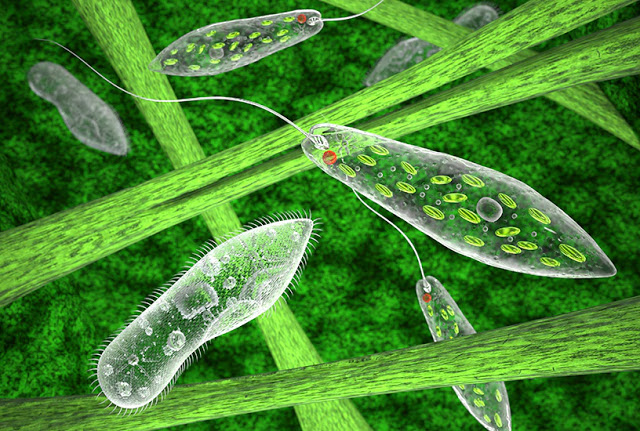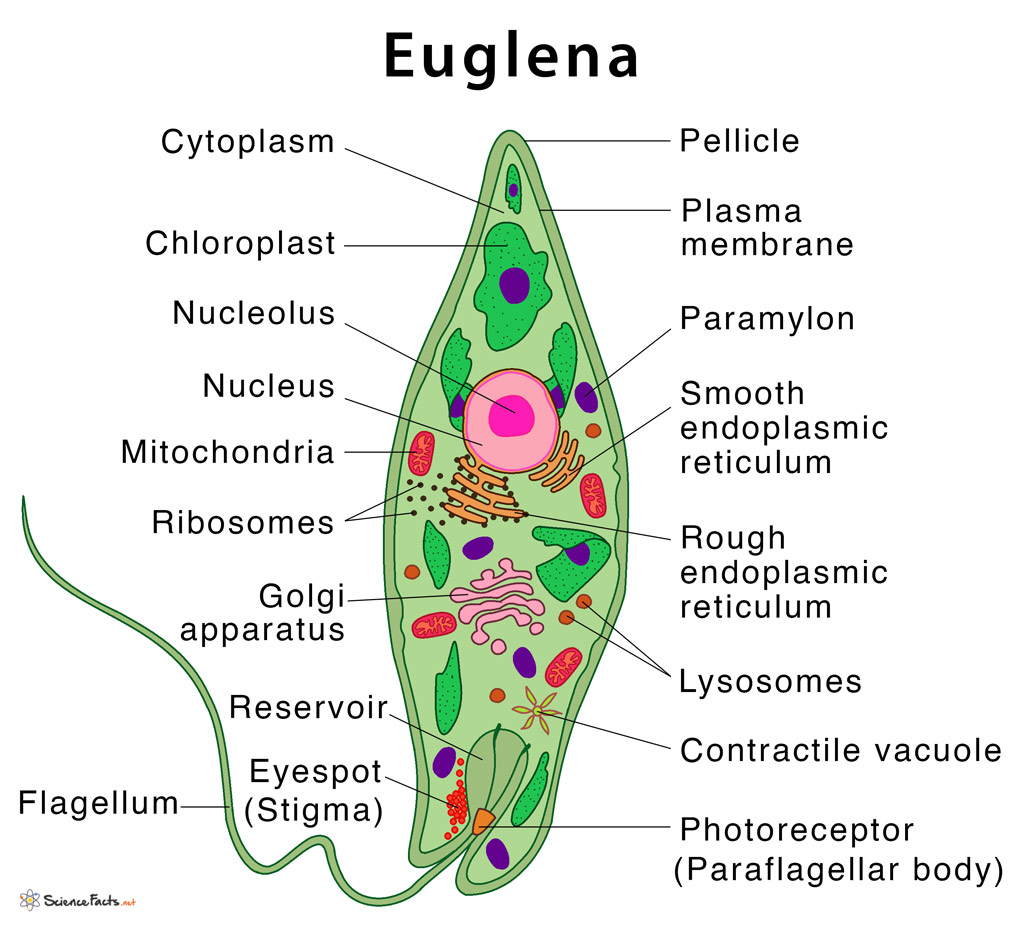Euglena
What is Euglena
Euglena is a motile, single-celled (unicellular) organism that is commonly found in aquatic habitats. They were among the first organisms in the kingdom Protista to be seen under the microscope, looking like a tiny particle making small movements in the water. Euglena is generally green in color due to the presence of chloroplast, the organelle that helps them to perform photosynthesis.
Unlike the photosynthetic group, there is a parasitic group of Euglena that causes serious blood and tissue diseases such as African sleeping sickness and leishmaniasis in humans.
Where do Euglena Live
Over 1000 different Euglena species are found in freshwater and saltwater habitats such as ponds, lakes, streams, rivers, and waterlogged areas like marshes.
Scientific Classification
| Domain | Eukaryota |
| Kingdom | Protista |
| Phylum | Euglenozoa |
| Class | Euglenoidea |
| Order | Euglenales |
| Family | Euglenaceae |
| Genus | Euglena |
Structure
Euglena is an elongated or spindle-shaped cell with a size around 15-500 x 10-6 m.
Parts
The internal structures found in a typical photosynthetic Euglena are as follows:
- Pellicle: A thin, flexible membrane that supports the plasma membrane and helps them to change shape
- Plasma Membrane: The selectively permeable membrane that protects the inner content of the cell from the outside environment
- Cytoplasm: A jelly-like substance distributed throughout the cell that contains all the cell organelles
- Chloroplast: Contains the green pigment chlorophyll that helps them to produce food using sunlight by photosynthesis
- Nucleus: A membrane-bound organelle that contains the genetic material, DNA. It also contains a distinct nucleolus that contains RNA and helps the cell to synthesize proteins
- Mitochondria: The energy-producing organelle that forms ATP. All cellular activities such as movement and reproduction are performed using the mitochondrial energy source
- Ribosomes: Consists of RNA and proteins, and are responsible for producing all cellular proteins
- Golgi Apparatus: Manufactures, stores, and transports large molecules such as carbohydrates and proteins within the cell
- Endoplasmic Reticulum: The extensive network of membranes that helps to package and transport proteins to different organelles. It is of two types: rough endoplasmic reticulum (RER) – containing ribosomes attached to it; and smooth endoplasmic reticulum (SER) – devoid of ribosomes
- Lysosomes: Small membrane-bound organelles filled with hydrolytic enzymes that break down large molecules such as carbohydrates, fats, and proteins
- Contractile Vacuole: It maintains the water and salt balance within the cell
- Reservoir: The inward pocket present near the base of the flagella where contractile vacuole dispels excess water
- Flagellum: A long whip-like structure attached externally to the cell body that helps in cell movement. An amoeba contains two flagella, a short one that does not protrude out of the cell, and a long one that helps in swimming
- Eyespot: A region that is highly colored and contains red-colored carotenoid pigments that help in the detection of light. It is sometimes called a stigma
- Photoreceptor: Also known as the paraflagellar body, it is the light-sensitive region located near the flagellum that helps to detect light. It also helps in their movement towards and away from light stimuli, a process known as phototaxis
- Paramylon: They are stored starch-like carbohydrate granules composed of glucose produced during photosynthesis. Paramylon enables the organism to survive in low-light conditions when photosynthesis is not possible by acting as the food reserve for the cell. When the paramylon is enclosed in a sheath of polysaccharide, it is called the paramylon sheath of pyrenoid.
Characteristics
How Is Euglena Similar to Plants
It is unique as it shows the features of both plant and animal cells. Like plant cells, some Euglena species are autotrophs and thus have the ability to use sunlight to prepare their food. However, others show features of an animal cell as they move from one place to another to acquire food from the environment.
How do They Move
Euglena moves forward and backward (bidirectional movement) using a long whip-like structure called a flagellum that acts like a little motor. The other part that plays a vital role in giving a sense of direction to its movement is the eyespot that helps to detect sunlight and produce food by photosynthesis. This is how Euglena responds to stimuli and performs the movement.
How Do Euglena Eat
It exhibits a mixotrophic mode of nutrition that uses a mix of both autotrophic and heterotrophic modes. While the photosynthetic species are autotrophs, others are found to be heterotrophs that obtain nutrients in the form of bacteria and algae through absorption by phagocytosis.
How Do They Respire
Euglena takes in free oxygen dissolved in water and breathe out carbon dioxide by diffusion through the pellicle and thus have ecological importance in purifying the atmosphere.
How do Euglena Reproduce
Most of the Euglena life cycle consists of a free-flowing stage and a non-motile stage. During the free-flowing stage, Euglena reproduces by an asexual method known as binary fission, where the parent cell divides equally to form two equal daughter cells. When the growth conditions become unfavorable, the cells of Euglena enclose themselves within a thick-walled protective covering called a cyst. This is the characteristic of their non-motile stage.
Some Euglena species also reproduce by forming reproductive cysts. During this period, they discard their flagella and become enveloped in a gelatinous, gummy substance to form reproductive cysts. Individual cysts then undergo binary fission to produce as many as 32 or more identical daughter-Euglena cells. When the conditions become favorable for growth, these daughter cells become flagellated and are released from the gelatinous mass to form actively dividing reproductive cells.
They have some other characteristic features, including the following:
- Lack a cell wall
- Require organic nutrients and vitamins such as vitamin B12 for their growth and development
- Some species contain vitamin E (⍺-tocopherol) and high content of astaxanthin in their cell
- Some species produce an alkaloid known as euglenophycin, which is found to kill fishes
FAQs
Ans. Euglena is a eukaryotic organism because of the presence of membrane-bound organelles, including a well-defined nucleus similar to all higher animals.
References
-
References
Article was last reviewed on Saturday, July 4, 2020





